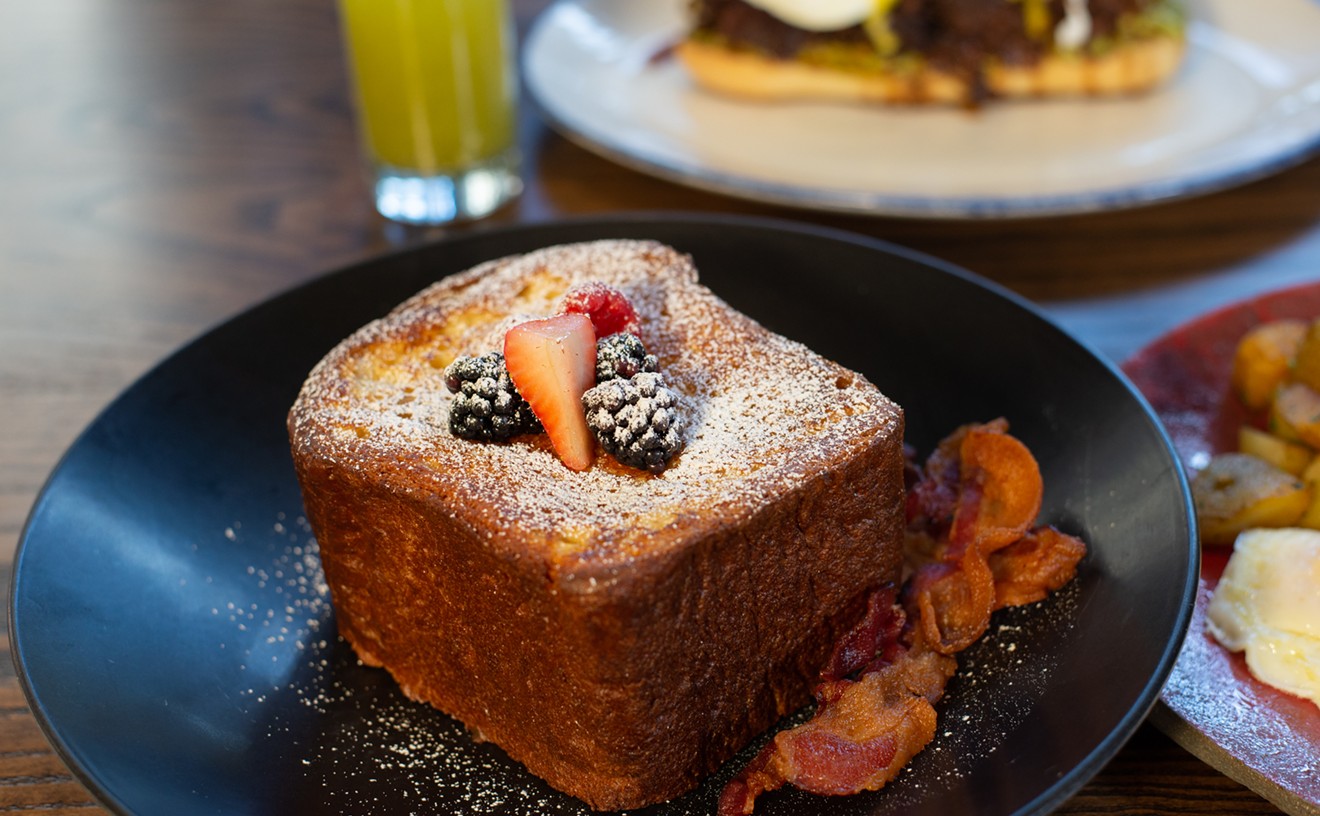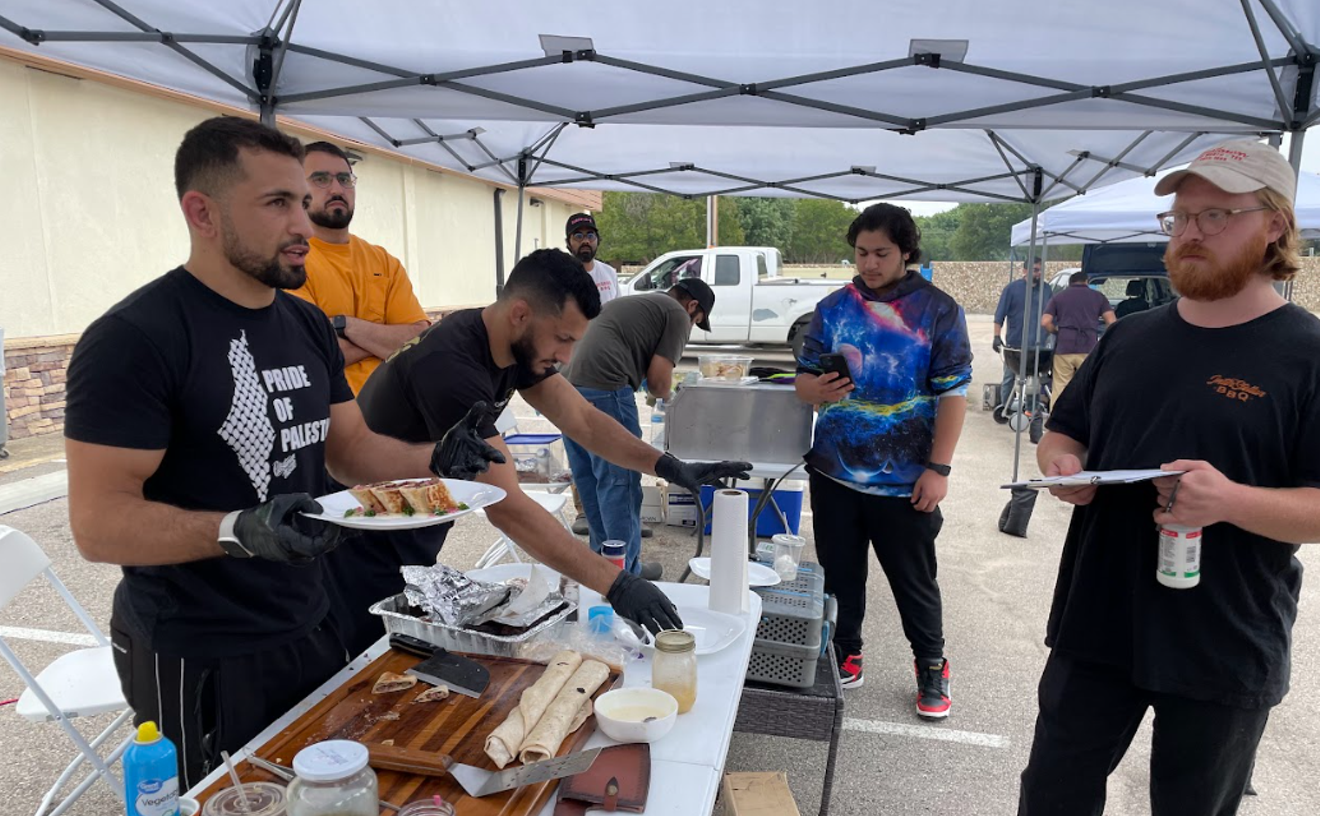We devised a similar test in response to this week's Burning Question: a cage match pitting Central Market against Whole Foods and Tom Thumb. At stake is America's complicated relationship with mass consumption, our alternating faith in past and progress, the oft-bitter rivalry between convenience and quality.
In other words, is Central Market really worth it?
You see, food has become a battleground, a disputed territory between multinational corporations rapidly assimilating all cultures into a homogenous McWorld vs. proponents of "slow foods" or quality ingredients. Stepping into a typical supermarket, shoppers encounter stacks of promotional items, banking facilities, cardboard Jeff Gordon props, oh, and food. Grocery stores have become massive convenience outlets. More than 90 percent sell greetings cards, almost half offer pharmacies and one in five provides gasoline. Their hallmarks are consistency, blandness and the brand name.
At Central Market, on the other hand, shoppers may catch a glimpse of some food item through a momentary, and all too narrow, breach in the crowd. To enter the place on a weekend is to experience a human traffic jam. Yet stalwarts will put up with the inconvenience, just so long as they have access to star fruit and Devon cream butter.
"At Central Market, the quality is there," says Marc Cassel, chef at the Green Room. "I go screaming from Albertson's and those places."
While a typical grocery store carries more than 30,000 mostly prepackaged items, Central Market stocks 30,000 different fresh tomatoes, or so it seems. Actually, they sell more than 700 produce varieties, 100 types of fish and seafood and so on.
The Test
Three of Dallas' best chefs--Cassel from the Green Room, Gilbert Garza of Suze and David McMillan at Nana--agreed to participate in a scientific experiment so airtight, the results must be considered unassailable.
Granted, they only agreed after the Burning Question crew threatened to become regulars at their establishments should they refuse to participate, but still.
We gave them each $25 (the most we could pry from our editor's clenched fists; fortunately it matches the average per-customer transaction at American supermarkets, according to the Food Marketing Institute) and asked them to prepare meals created from ingredients purchased at one of the aforementioned stores. The experiment presumed the existence of a pantry. In other words, the chefs could use salt, pepper and other basic staples from their restaurant kitchens. Otherwise, everything came straight from the store.
Garza drew Whole Foods, Cassel pulled Central Market from the hat (actually a used Styrofoam cup) and McMillan got Tom Thumb.
His words when we revealed the news: "You suck."
To judge the event, we called upon an accumulation of talent not seen since Marcia Clark assembled Nicole Brown Simpson's legal team: chef Nick Badovinus of Cuba Libre, Bamboo Bamboo and Sense; Jim White, host of the KRLD Restaurant Show and critic for eatsanddrinks.com; and Brooke Gregory, an occasional Burning Question crew member who had never dined at a fine restaurant because she's generally comatose by the end of happy hour.
Of course, that could be said of any crew member.
Gregory, for one, was skeptical of our experiment's structure. Chefs, she reasoned, would skew the results: "Their main concern is taste, not getting the four food groups in." For the record, the Burning Question crew considers those groups to be salt (chips, bacon), sugar (cookies, gelato), coffee and alcohol.
The Dinners
Suze (Whole Foods). Garza prepared four courses, starting with Ruby trout doused in cracked black pepper and lime juice. "I'd like to see people put that on the menu," White says. "It was an inspired choice." Inspired, and inexpensive: Garza bought one trout for $5.09 and sliced it thin. He shelled out an additional 50 cents for limes. Next he served a plum tomato and baby arugula salad with a balsamic reduction glacé, followed by braised rib (one each) over risotto, drizzled with hollandaise. "One of the most balanced presentations I've experienced," according to White.
The trick, Badovinus explains, is to satisfy the palate rather than stuff the plate. "It's a flavor-reward system," he says. "You don't need to overwhelm." Indeed, a whopping $1.69 worth of ribs and a $3.29 package of risotto worked for four people. "I couldn't eat the whole thing," Gregory agrees.
"The dish was great," Badovinus concludes. "It shows what you can do with a less expensive cut of meat and the correct method."
For dessert, Garza whipped up a bread pudding with blackberries reduced in orange and white wine. The wine perhaps pushed the limits a bit--he grabbed some from the restaurant's stock--and he slipped a bit on the spending rules, cashing out at $26.24.
"The biggest challenge was finding good product in small quantities," Garza says of the experience. Green Room (Central Market). Badovinus suggested early on that Central Market offered the greatest challenge under the rules. The place simply costs more than a traditional supermarket.
"I will say what they had was expensive," Cassel acknowledges. "There was a lot I wanted to use but couldn't afford."
He managed one course for $24.81, a beautiful fennel cured pork with fingerling potatoes, sweet onions and Easter egg radishes, served in a portobello mushroom butter. The dish looked and tasted like it belonged in a fine-dining restaurant.
"The quality of the protein is incredible; it just melts," Badovinus said at the time. "That's why your dollar doesn't travel as well." In fact, the tenderloin, potatoes and imported butter accounted for $17.19 of Cassel's total. "I was aghast at the prices in general," he says. Chefs, after all, know the wholesale price of each item and instantly recognize markup amounts.
"I was scrambling at the end. I had to put back some potatoes." Hmmm...we've been compelled to put items back on the shelf, as well. Different circumstances, though.
Nana (Tom Thumb). Just the thought of sitting at one of the city's most expensive restaurants dining on cheap supermarket fare struck us as humorous. McMillan, however, was none too pleased with the draw: The special menu he printed for the event, titled "The How I Got Hosed By Dave Dinner," tipped us off.
Chefs just don't visit supermarkets. Purveyors, after all, reserve better items for fine-dining establishments. The remains end up in casual chains and grocery stores. Chefs regularly handle diver-harvested scallops, Copper River salmon and real Parmigiano-Reggiano cheese. "A grocery store experience, to me, is about sustenance," Badovinus explains. "I'll buy chicken and pork butt at the store, but that's it. You can't compete with the quality of product available to restaurants."
Yet McMillan managed three courses from Tom Thumb's limited selection.
He started us off with an eggplant gratin topped by a roasted tomato vinaigrette and mesclun salad. The seasoning was dramatic and the texture quite comforting, but the supermarket greens fell a bit short. "They had decent produce," McMillan says of his local Tom Thumb. "Rudimentary, but decent." That said, the appetizer was very enjoyable.
As an entrée, McMillan served molasses-cured pork tenderloin, accompanied by a cauliflower purée and rhubarb chutney. The latter was an interesting selection, providing a tart balance to the sweetness of molasses. "I bought rhubarb, and the lady said she hadn't sold any in five years," the chef says. "Then she rang it up as rutabaga, so instead of $2 it was 98 cents. So I went back and bought cream." Aside from a few basic points of curiosity--Was it the same rhubarb? Was McMillan serving us fermented veggies out of spite?--his story exposed another difference between high-end markets and common grocery stores: expertise.
Again, the chef's skill turned an inferior product into something worthwhile. "The overall dish had a great flavor," White says, "though you could tell the difference in quality in the cut of meat."
An apricot tarte Tatin completed our meal--an outstanding dessert. The entire meal cost just under $25.
Conclusion
"The food was excellent, better than I've ever cooked in my existence," Gregory says. From a few bucks, ingredients available to average consumers and a fully stocked professional kitchen staffed by experienced line cooks, our test chefs knocked out three very respectable meals.
"It's hard to believe it was only $25," Gregory continues, "because I've made fajitas for two people and it cost almost that much and didn't taste that good."
Certainly chefs have an edge over the rest of us, even if you shove them into a common supermarket. "The biggest advantage is that I can look at stuff and know whether it's worth walking over to the bin," Cassel says. "I know what's going to suck." At each location, however, the chefs found something worthwhile. The combination of quality and price allowed Garza to pursue some innovative choices at Whole Foods. Cost drove the selection of ingredients at Central Market, while the search for quality shaped McMillan's Tom Thumb agenda.
"I've been doing this for a long time, and certain things are classic," Nana's McMillan says. "The logic that makes them classic applies to so many things, you just go on that."
In other words, a little knowledge will allow consumers to find something decent, no matter where they shop or how much they can spend.
"I always tell people to pick one good thing and three or four recipes they can do really well," Garza says. "If you know how to cook risotto, then experiment from there."
So, is Central Market worth it? We noticed a difference in basic quality, but even stuff from Tom Thumb seemed palatable when prepared by a skilled and creative chef. "You're relegated to some inexpensive meats, and I would not buy fish at any of those places [supermarkets]," McMillan says, "but by not going to Central Market, I could afford to buy more than one thing."
As for the struggle between convenience and quality, our research is best summed up in Badovinus' sage words: "I think that if I didn't know the difference between prime beef and choice, how much easier my life would be."
And you can't argue with that.










